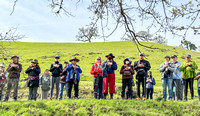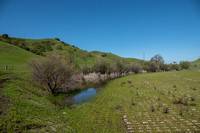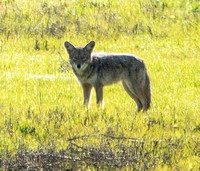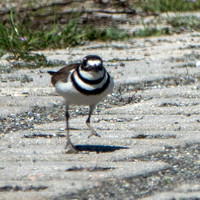Created 27-Mar-23
Participants in Green Foothills’ Healing in Nature series gather on a sunny morning in a seldom-visited preserve in northern Coyote Valley. We are led by healers Amari Thomas and Smita Garg, and naturalists Craige Edgerton and Michael Hawk, with a little bit of help from Helen and me. It is a quiet, simple walk, along a berm between Fisher Creek and oak-studded hillsides, then along a seasonal pond, usually dry. We look out on wide flat areas, now grassy but soggy; much of this land has been underwater this season, as the water spreads out and sinks into the ground, sparing downstream residents from flood danger. Even now, a large lake remains at Laguna Seca (“Dry Lake”). On the other side of our path, grassy hillsides are sprinkled with twisted Valley Oaks, their varied greens showing different stages of leafing out. We take deep breaths and experience what is offered, including springtime plants, birds, and animals, and their connections in the web of life.
These galleries combine photos from our outing on March 18 and our scouting trip on March 16. We visited some slightly different locations on each visit, and saw different wildlife – a coyote on March 16, a resting rare California Red-sided Garter Snake on March 18. On the scouting trip we watched a pair of Killdeer scout out possible locations for a nest – right in the middle of the raised berm, amongst the paving pieces. (Killdeer somehow survive, despite often choosing flat areas in parking lots or roads for nests.) The separate galleries here focus on people and ceremonies; landscapes and plants; and birds and wildlife. The last gallery follows the Killdeer pair on their scouting foray.
This area bordering Laguna Seca, officially known as the North Coyote Valley Conservation Area, is part of 1000 acres protected in 2019 by a public-private partnership involving the Santa Clara Valley Open Space Authority, the City of San Jose, and the Peninsula Open Space Trust (POST). Green Foothills and many other conservation organizations were deeply involved in the decades-long struggles to bring this result to fruition.
Coyote Valley is an ecologically rich area just south of the developed part of San Jose. Its diverse adjacent ecosystems engender biological richness. It provides a key linkage between the Santa Cruz and Diablo mountain ranges. Laguna Seca floods in rainy periods, providing storm relief for San Jose, recharge of underground water storage, and habitat for a wide variety of migratory birds and many other creatures.
In the 1980s, the City of San Jose designated Coyote Valley for industrial development. Major office and residential complexes were planned. The environmental community pushed back. This was touch and go for decades. In 2017, Coyote Creek flooded downstream of Laguna Seca – this helped tip the scales. In 2018, voters in San Jose approved Measure T, which provided funds for the protection of this area. Check out the Green Foothills’ website or google “North Coyote Valley Conservation Area” for more information. (Just below where we walked, Fisher Creek flows into Coyote Creek, which passes through urban San Jose into the Bay.)
Planning is underway to open more of the area to the public.
We are lucky to have this piece of Coyote Valley now preserved. Paving it over would have been an expensive disaster, hard to unwind. Thanks to all who helped get to this point! And let’s keep it up: there are still threats of unwise development in other parts of Coyote Valley.
These galleries combine photos from our outing on March 18 and our scouting trip on March 16. We visited some slightly different locations on each visit, and saw different wildlife – a coyote on March 16, a resting rare California Red-sided Garter Snake on March 18. On the scouting trip we watched a pair of Killdeer scout out possible locations for a nest – right in the middle of the raised berm, amongst the paving pieces. (Killdeer somehow survive, despite often choosing flat areas in parking lots or roads for nests.) The separate galleries here focus on people and ceremonies; landscapes and plants; and birds and wildlife. The last gallery follows the Killdeer pair on their scouting foray.
This area bordering Laguna Seca, officially known as the North Coyote Valley Conservation Area, is part of 1000 acres protected in 2019 by a public-private partnership involving the Santa Clara Valley Open Space Authority, the City of San Jose, and the Peninsula Open Space Trust (POST). Green Foothills and many other conservation organizations were deeply involved in the decades-long struggles to bring this result to fruition.
Coyote Valley is an ecologically rich area just south of the developed part of San Jose. Its diverse adjacent ecosystems engender biological richness. It provides a key linkage between the Santa Cruz and Diablo mountain ranges. Laguna Seca floods in rainy periods, providing storm relief for San Jose, recharge of underground water storage, and habitat for a wide variety of migratory birds and many other creatures.
In the 1980s, the City of San Jose designated Coyote Valley for industrial development. Major office and residential complexes were planned. The environmental community pushed back. This was touch and go for decades. In 2017, Coyote Creek flooded downstream of Laguna Seca – this helped tip the scales. In 2018, voters in San Jose approved Measure T, which provided funds for the protection of this area. Check out the Green Foothills’ website or google “North Coyote Valley Conservation Area” for more information. (Just below where we walked, Fisher Creek flows into Coyote Creek, which passes through urban San Jose into the Bay.)
Planning is underway to open more of the area to the public.
We are lucky to have this piece of Coyote Valley now preserved. Paving it over would have been an expensive disaster, hard to unwind. Thanks to all who helped get to this point! And let’s keep it up: there are still threats of unwise development in other parts of Coyote Valley.
People
Visitors 10
12 photos
Created 28-Sep-23
Modified 28-Sep-23

Landscapes
Visitors 3
24 photos
Created 28-Sep-23
Modified 28-Sep-23

Birds and Other Creatures
Visitors 6
18 photos
Created 28-Sep-23
Modified 28-Sep-23

Killdeer Nesting Behavior
Visitors 3
26 photos
Created 28-Sep-23
Modified 28-Sep-23

Dan Quinn